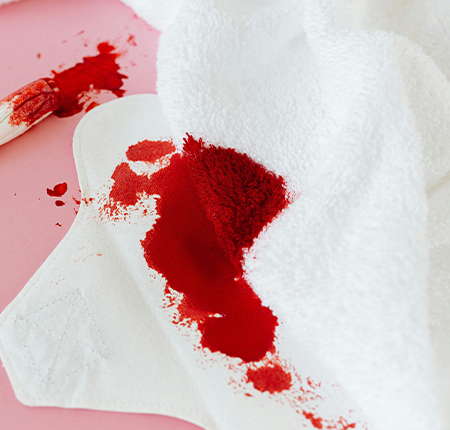
Lochia, that discharge that occurs immediately after birth, is normal. It happens regardless of the type of birth, natural or cesarean. This is how your body gets rid of the blood and tissues left in the womb that supported the baby's growth.
All women bleed after childbirth, most profusely in the first few days, which is not a cause for concern. It should be, however, if the bleeding continues as profuse even after several weeks. Here's what you should know about lochia and what to look out for.
What are lochia (bleeding after childbirth) and why do they occur?
Lochia is the vaginal bleeding that occurs immediately after birth and can last for several weeks, being more abundant in the first days and gradually reducing until they disappear completely. They are similar to menstrual bleeding, having a similar, metallic texture and smell.
Lochia contains a combination of blood, secretions and uterine tissue, remnants of what during pregnancy helped the development and growth of the fetus.
They do not appear as a negative consequence or as a problem, but are a natural element of the healing process that the mother's body goes through in the postpartum period. Lochia is normal and most of the time it goes away without complications or cause for concern.
How normal lochia manifests itself after childbirth
Immediately after birth and in the first few days, lochia can be very heavy, and it can remain so even after you leave the hospital and go home with your baby. Especially if you move a lot and overload your body. You will feel the discharge especially when you are standing, due to the shape of the vagina.
Only after a few days does the flow of this bleeding begin to decrease. As the bleeding reduces to occasional discharge, you will use fewer and fewer pads and you will be able to switch to panty liners (daily pads). It's important to use 100% organic cotton pads like Enroush, which are pH neutral and chemical free.
Your vaginal flora is constantly vulnerable, but even more prone to irritation and infection after childbirth, so protect it by using only menstrual products made from pure ingredients, without dyes and bleaches.
Postpartum vaginal bleeding develops differently for each woman. But in principle, there are three stages of lochia, which manifest themselves as follows:
Rubra (in the first 3-4 days): bright red or dark lochia, heavy menstrual-like flow, mild abdominal cramps
Serous (lasts between 4-12 days): more watery pinkish or brownish lochia, weaker flow than in the first days.
White (lasts between 12 days - 6 weeks): the last stage of lochia, manifests as light discharge or spotting of a yellowish or whitish color, with very little or no blood.
Every day is different, and the time it takes for lochia to disappear for good varies depending on several factors. In more detail about how postpartum discharge changes from one day to the next, we tell you below.
How long does vaginal bleeding last after childbirth
Although lochia can continue up to 8-12 weeks after birth, it normally changes most noticeably during the first 6 weeks. After that, those leaks that I was talking about, in the White stage, may still remain.
The biggest changes take place until week 6, so here's what you can expect each day:
Day 1: heavy flow, red or brown bleeding, small clots
Days 2 to 6: Light red or dark brown bleeding
Days 7 to 10: Same, light red or dark brown bleeding, but with changes in flow
Days 11 to 14: Light flow, dark brown bleeding
Weeks 3-4: light-colored bleeding, flow decreases even more
Weeks 5-6: brown spotting

What is the usual color and texture of lochia
Normally, I told you above how the natural color of lochia changes depending on the stage you are in postpartum. They can range from light red and dark red to brown, pink or light yellow towards the end.
What is not normal is for the bleeding to be a different color, for example greenish. Or keep the same bright or dark red color several days after birth. After the first two weeks, their color should change and the flow should decrease. Talk to your doctor if this does not happen.
As for the texture, it is normal for the lochia to contain small clots in the first few days. But they should not exceed the size of coins, and should be reduced. After the first 3-4 weeks, the clots should be very few, very small, or disappear altogether.
How lochia is different from menstruation
Although there are some similarities between lochia and menstruation (as we told you above about menstrual pain, smell, flow, presence of clots, etc.), the major difference between the two is how long they last.
Depending on the length of the menstrual cycle, menstrual days can last between 2 and 8 days. On our blog you will find a lot of comprehensive articles related to everything you should know about the menstrual cycle . Postpartum bleeding, on the other hand, lasts much longer than a normal period.
For most women, menstrual bleeding lasts about a week. Lochia, in most cases, lasts around 6 weeks.
Effects of vaginal bleeding after childbirth (lochia)
Although every mother's experience with lochia is different, there are a few factors that definitely have an effect on the amount of blood you lose. The flow may become heavier if:
You're breastfeeding: When you're breastfeeding, your body releases oxytocin, a hormone that helps the uterus contract, which is why your discharge happens at a faster rate (but you don't lose more blood, you just lose it more suddenly).
You stand up: the vagina is shaped like a cup. When you lie down or lie down, the discharge can accumulate in a larger amount in the vagina. But when you stand up, the vagina changes its position and all the accumulated fluid starts to drain.
Exercise: Any type of movement or physical activity, including climbing stairs, can speed up lochia drainage.
When to see a doctor if you have bleeding after giving birth
Usually there are no complications due to lochia, but there are exceptions. Always be on the lookout for bleeding or abnormal changes, and see a doctor as soon as possible if you notice any of the following symptoms:
Greenish discharge
Swelling of the area around the vagina
Pain in the vaginal area
An unpleasant smell, different from the normal one during menstruation
Clots larger than 4 cm
Numerous clots
Very strong pelvic pain and abdominal cramps
Very heavy bleeding (you have to change the pad every hour)
Dizziness and feeling faint
Flu symptoms, fever or chills
Causes of postpartum hemorrhage
It is called postpartum hemorrhage when lochia is excessively abundant, and uterine atony is the most common cause.
Normally, the uterus contracts postpartum and tightens to stop bleeding where the placenta (the organ that feeds the fetus) was during pregnancy. In the case of uterine atony , the uterus no longer has these normal contractions, which is why lochia becomes very abundant.
Also, women who give birth by cesarean section are more prone to postpartum hemorrhage than those who give birth naturally. But there are other factors that can increase the likelihood of, or cause, excessive bleeding, including:
Long labor
Oxytocin administered to induce labor
Birth of a baby weighing more than 4 kg
Birth of twins/triplets or multiple births
Injuries to the vagina, cervix or uterus at birth
General anesthesia for caesarean section
Placenta problems
Obesity
Preeclampsia (presence of excess protein in the urine and high blood pressure during pregnancy)
How is postpartum hemorrhage treated?
Depending on the cause and symptoms, your doctor may suggest various approaches to relieve postpartum hemorrhage. Different ways to treat heavy bleeding include:
Administering oxytocin or other drugs that cause uterine contractions
Administering medications that stop bleeding
Massaging the uterus to stimulate contractions
Removing remnants of the placenta from the uterus
Blood transfusion to replace large blood losses
Embolization of the uterine arteries to limit blood flow to the uterus
Insertion of a Bakri balloon which inflates into the uterus and applies pressure to stop bleeding
Surgery: If the causes of the bleeding are unknown, the doctor may perform a procedure to open the abdomen called a laparotomy to determine the cause and stop the bleeding; also, in certain cases, hysterectomy (removal of the uterus altogether) can be performed
Postpartum bleeding (lochia) tips and advice
Lochia is a normal stage in your body's natural recovery process postpartum. If there is no bleeding or other complications discussed above, they are not a problem that needs to be treated, but rather one more reason to treat your body gently and patiently.
Here are some recommendations that will be useful for you to take care of your body properly during the period of postnatal bleeding.
Use only absorbent pads for the first 6 weeks
Your vagina and entire reproductive system is very vulnerable immediately after birth. It is still recovering, and there may still be damage to the vaginal walls and cervix. Inserting any foreign body into the vagina can introduce bacteria that can reach the uterus and cause infection.
Make sure you talk to your doctor and get their confirmation before you start using tampons again. During the first 6 weeks, to avoid staining clothes, use only absorbent pads with a high absorbency level.
Enroush pads are made of 100% organic cotton and can provide you with safe protection without toxic substances that can cause irritation and infections of your intimate area. Plus, thanks to the 100% natural fiber bottom layer, anatomical design and cotton fins, they're super absorbent and won't allow any accidental stains or side leaks to stain your clothes.

Don't get too tired
We know there's so much to do around the house and you're needed everywhere - but these things will be the same in a few weeks, when the lochia clears up. The greatest need at this time, even of the baby, is to take care of yourself. This is the only way you can give him the attention and care he needs, so focus on rest and recovery.
Be patient and avoid strenuous activities: even vacuuming is physically demanding and can accelerate postpartum discharge. Don't get too tired and don't hesitate to ask your partner, family or friends for help when you need it.
Opt for clothing and underwear that you can live without
No matter how effective the absorbents are, lochia can be very abundant especially in the first days and especially in the morning or when you stand up suddenly. Sometimes spills and stains are unavoidable, and this shouldn't cause you extra stress.
So choose to wear clothing and underwear that you won't mind getting dirty. This way you can move quietly and feel comfortable, without worrying that your clothes must remain impeccable.






















